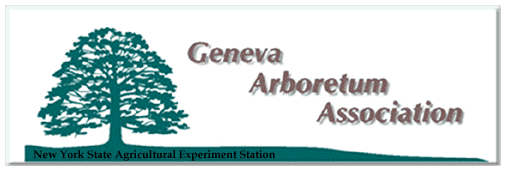

"Adding
trees and shrubs to your landscape in the springtime is a lifetime investment,"
according to Catherine Heidenreich, (Plant Pathologist and) Technician
at the New York State Agricultural Experiment Station in Geneva, NY, who
is a member of the Geneva Arboretum Association. She recommends homeowners
make a trip to their local library to find information on the specimens
under consideration before purchasing them.
"Take time before buying to consider just what you are hoping to achieve
in adding a particular tree or shrub to your yard," said Heidenreich.
"This is time well spent and can add to your success and enjoyment
in home landscaping."
The Arboretum Association is an 8-year-old organization of employee volunteers
that coordinates the annual Arbor Day Tree planting at the Station, in addition
to making recommendations to the Buildings and Properties Department about
landscaping decisions for the Station campus and rock garden throughout
the year. Many people know that the Station has 700 acres of fruits and
vegetables used for research and extension; few know that the Station also
has over 200 woody species in its ornamental collection, represented
by twice as many individual specimens.
Here are a few questions to ask before you plant.
1. What effect or purpose am I hoping to achieve with this plant? Is
it for shade, to attract wildlife such as birds, to add texture or contrast,
for screening or fencing, for fall color, flowers or fruit? Be sure your
selected plant will fill the intended needs. A wind-break specimen that
looses its leaves in the winter may not afford much relief from the wind!
Consider the plant's ultimate size and shape, foliage type, and root system.
Will the plant be too large, too small, too open, too dense? Be sure to
consider how it will look from inside the house as well as from outside!
2. What size plant is required? In general, trees fall into three
size categories: large, medium, and small. Large trees are 40100 ft tall
at maturity and dominate the landscape. They need to fit into the scale
of existing plantings and buildings. These trees are often selected for
shading houses or creating a focal point in the landscape.
Medium trees are 30-50 ft tall and are used for street tree plantings, shading
lawns and terraces, and where large trees would be out of scale. Small trees
are up to 25 ft tall and are used where space is limited. They are selected
for their special characteristics such as foliage or flowers, shape or form
and are often planted as a contrast to the background buildings or plantings.
Shrubs can be divided into four main groups: fingertip high (7 ft or higher),
head high (5 to 6-1/2 ft), waist high (2-1/2 to 3-1/2 ft) and knee high
(1-1/2 to 2 ft), although you may find shrubs on a spectrum anywhere from
4 inches to over 10 ft in height. Width is also an issue to consider, as
shrubs come in different shapes: upright/columnar, spreading, rounded (largest
mass) and vase-shaped. Remember, most shrubs can be pruned to any desired
shape and size but will look better and be less work if they are pruned
only to enhance the natural shape. Shrubs are used to separate areas, define
spaces, and create contrast.
3. Is the plant I have selected able to grow well on my site?
What is the soil type, drainage, exposure? Is the plant hardy for my
zone (Zones 4 to 5 in most of New York)? Does it have special growth requirements
such as soil pH, partial shade, well drained soil, or protection from the
wind?
4. Will there be sufficient space for the plant on this site when it
reaches maturity? Allow sufficient space from the house and from other
nearby plantings. Base your spacing on the mature sizes of the trees and
shrubs to avoid problems later. Consider getting the largest specimen affordable
to help reduce time to maturity and better estimate spacing. If smaller
specimens are planted, fill in with perennials or bulbs, which can be removed
or relocated as the plants increase in size. Will the plant obscure walls,
windows, or doors when fully grown? Will it crowd sidewalks or fences? Is
it going to be situated under overhanging roof gutters? A quick walk or
drive through your town or neighborhood will make very obvious the need
not to overlook this step!
5. How much maintenance will be required to keep the specimen attractive
and healthy? Do I have the time, equipment and knowledge to do what
is required? Are there disease or insect problems? If so, are there resistant
cultivars to plant? Will the plants need to be watered regularly? How much
pruning is required? Is it a tree that looses leaves, branches, nuts, cones
or other debris which has to be raked up and removed? Is there added expense
involved for special site preparation, fertilization, pesticide application?
6. Does the plant I have selected pose any hazards? Are the plant
parts poisonous to children or domestic animals? Will thorns or briars pose
a problem? Does the plant have a disagreeable odor while flowering? Am I
planting a tree too near the house that is susceptible to wind throw, splitting
or loosing large branches?
There are perhaps other things to consider not mentioned here and you may
never find that "perfect match" plant that meets or exceeds all
your requirements. In any case, you will find that you have better success
if you do a little homework before you plant!
(If you are interested in more information, these and many other home landscaping
facts may be found in Reader's Digest Practical Guide to Home Landscaping.1972.
Published by The Reader's Digest Association, Inc. Pleasantville, New York.
or check your local library for other home landscaping references.)
Written by Cathy Heidenreich
Next (Beautiful Beechs)
Return to Arboretum Home Page
Return to NYS Agricultural Experiment Station Home Page
Page maintained by Thomas Björkman
Last modified January 21,1998
http://www.nysaes.cornell.edu/arboretum/l_tulipifera.html